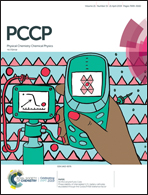Study of electronic structure in the L-edge spectroscopy of actinide materials: UO2 as an example†
Abstract
While the electronic structure calculation for actinide materials, using ligand-field phenomenology in conjunction with density functional theory (LFDFT) treating configurations with single or two open-shells 5f and 6d electrons, is well established and currently practiced, the consideration of the three open-shells electron configurations for LFDFT treatment is a challenging task addressed in the present work. Herein, we report the first-principles method, developed for the first time on the basis of LFDFT, to evaluate the uranium L3-edge X-ray absorption near-edge structure (XANES), which requires non-equivalent active electrons within the 2p, 5f and 6d orbitals of the uranium ion. The theoretical results, when compared with the experimental XANES data measured from uranium dioxide fresh fuel pellets and rector-exposed spent fuel materials, show good agreement with the experimental findings elucidating the local oxidation in the spent fuel materials. This report is relevant for the commonly used L-edge spectroscopy of actinide isotopes and important for understanding the structural, optical and electronic properties of actinide-based materials.

- This article is part of the themed collection: 2019 PCCP HOT Articles


 Please wait while we load your content...
Please wait while we load your content...